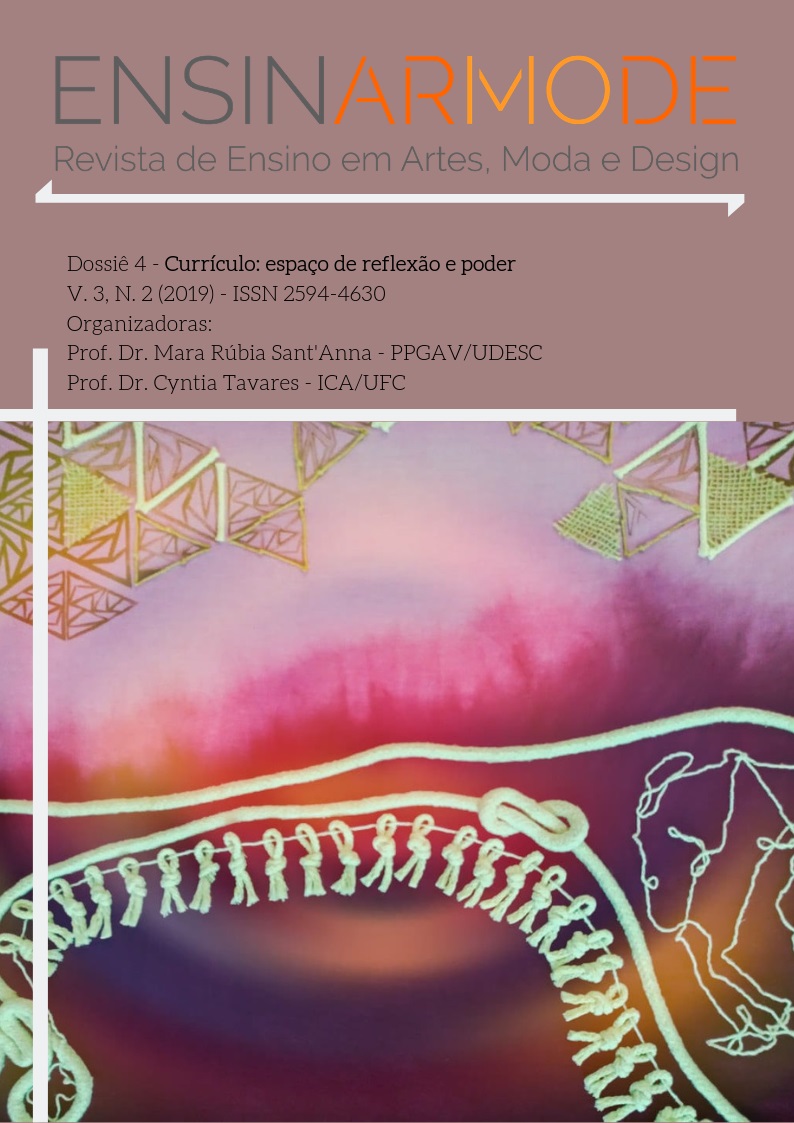ENSINO DE ARTE: UM EXERCÍCIO SOBRE A LUZ E A SOMBRA COMO EXPERIÊNCIA POÉTICA EM SALA DE AULA
DOI:
https://doi.org/10.5965/25944630322019054Abstract
A presente pesquisa teve como objetivo revelar as potencialidades do educador e do aluno, adquiridas por meio das experiências poéticas em sala de aula e, assim, evidenciar a relevância da Arte na educação. O estudo foi aplicado nas turmas de 1º ano do Ensino Fundamental I (seis anos) de uma escola privada no interior do estado de São Paulo, enfatizando o conteúdo abordado sobre a luz e a sombra, ocorrido no terceiro trimestre no ano com duração de doze aulas. Ancoramos nossa reflexão em John Dewey, Lev Vygotsky, Ana Mae Barbosa, Ana Angélica Albano, Rosa Iavelberg.Downloads
Riferimenti bibliografici
ARSLAN, Luciana Mourão; IAVELBERG, Rosa. Ensino de Arte. São Paulo: Thompson, 2006.
BARDIN, Laurence. Análise de Conteúdo. Lisboa: Edições 70, 2002.
DERDYK, Edith. O desenho da figura humana. São Paulo: Scipione, 1990. 174p. Série Pensamento e ação no magistério.
DEWEY, John. Arte como experiência. São Paulo: Martins Fontes, 1980.
IAVELBERG, Rosa. Desenho na Educação Infantil. São Paulo: Melhoramentos, 2013.
PRATES, Valquíria; SANT’ANNA, Renata. O olho e o lugar: Regina Silveira. São Paulo: Paulinas, 2009.
PRÍNCIPES e Princesas. Direção e Criação: Michel Ocelot. França: Dolby Digital, 1999. (70 min). DVD.
SMITH, Edward Lucie. Arte Moderna. História da Arte e crítica de arte In: BARBOSA, A. M. (org). Arte/Educação Contemporânea: Consonâncias Internacionais. São Paulo: Cortez, 2005. Parte 1, cap. 1, p.25-39.
SMOLKA, Ana Luiza. Criação e Imaginação. In: VIGOTSKI, Lev S. Imaginação e criação na infância: ensaio psicológico: livro para professores. Trad. Zoia Prestes. Apresentação e omentários: Ana Luiza Smolka. São Paulo: Ática, 2009.
Downloads
Pubblicato
Come citare
Fascicolo
Sezione
Licenza
- Gli autori conservano i diritti d'autore e concedono alla rivista il diritto della prima pubblicazione, con l'opera simultaneamente licenziata sotto la Licenza Creative Commons Attribuzione 4.0 Internazionale, la quale permette:
1. Condividere — copiare e ridistribuire il materiale su qualsiasi supporto o in qualsiasi formato, per qualsiasi fine, anche commerciale.
2. Adattare — remixare, trasformare e creare a partire dal materiale per qualsiasi fine, anche commerciale. Il licenziante non può revocare questi diritti finché vengono rispettati i termini della licenza.
In accordo con le seguenti condizioni:
1. Attribuzione — È necessario attribuire la paternità dell'opera in maniera appropriata, fornire un link alla licenza e indicare se sono state effettuate delle modifiche. Questo deve essere fatto in qualsiasi circostanza ragionevole, ma non in modo tale che suggerisca che il licenziante avalli l'utilizzatore o il suo utilizzo.2. Nessuna restrizione aggiuntiva — Non è possibile applicare termini legali o misure tecnologiche che limitino legalmente altri dallo fare qualsiasi cosa la licenza permetta.
-
Il plagio, in tutte le sue forme, costituisce un comportamento editoriale eticamente scorretto ed è inaccettabile. Questa rivista utilizza il software di controllo della similarità iThenticate.






